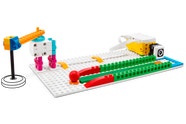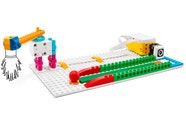SPIKE™ Essential
Avoid the Edge
Challenge yourself to use different bats to make the ball stop at the target!
30-45 min.
Beginner
Grades 3-5

Prepare
- Review the Avoid the Edge lesson in the LEGO® Education SPIKE™ App.
- If necessary, pre-teach these related vocabulary words: impact, kinetic energy, and target.
- Consider the abilities and backgrounds of all your students. Differentiate the lesson to make it accessible to everyone. See the Differentiation section below for suggestions.
- If time allows, plan and facilitate the math extension. See the Extension section below for more information.
Engage
(Whole Class, 5 Minutes)
- Facilitate a quick discussion about energy changing from potential (stored) to kinetic (motion) energy.
- Talk with your students about what happens to a ball’s energy right before it's set in motion.
- Ask questions, like: What type of energy did the ball have before it was set in motion? What type of energy did it have after?
- Introduce your students to the story’s main characters and the first challenge: making the ball stop at the target to win the game.
- Distribute a brick set and a device to each group.
Explore
(Small Groups, 30 Minutes)
- Have your students use the LEGO® Education SPIKE™ App to guide them through their first challenge:
- Create and test the program that makes the ball stop at the target.
- Have your students iterate and test their models to complete the next two challenges in the app:
- Modify the program to improve the game.
- Upgrade the bat and see how it impacts the game.
- You can find coding and building support in the Tips section below.
Explain
(Whole Class, 5 Minutes)
- Gather your students together to reflect on their completed challenges.
- Ask questions, like: How did you program the game to make sure the ball stopped at the target? How did changing the bat affect the game and the ball's energy?
Elaborate
(Whole Class, 5 Minutes)
- Prompt your students to discuss and reflect on ways of impacting the ball's energy.
- Ask questions, like: *How does changing an object's size affect its conversion from one type of energy to another? How does changing an object's texture affect its conversion from one type of energy to another? *
- Have your students clean up their workstations.
Evaluate
(Ongoing Throughout the Lesson)
- Ask guiding questions to encourage your students to “think aloud” and explain their thought processes and reasoning in the decisions they've made while building and programming.
Observation Checklist
- Measure your students’ proficiency in explaining how energy is converted from one form to another.
- Create a scale that matches your needs. For example:
- Needs additional support
- Can work independently
- Can teach others
Self-Assessment
- Have each student choose the brick that they feel best represents their performance.
- Yellow: I think I can explain how energy is converted from one form to another.
- Blue: I can explain how energy is converted from one form to another.
- Green: I can explain how energy is converted from one form to another, and I can help a friend do it too.
Peer-Feedback
- In their small groups, have your students discuss their experiences working together.
- Encourage them to use statements like these:
- I liked it when you…
- I'd like to hear more about how you…
Tips
Coding Tip
- After your students complete their first challenge, they'll be provided with three Inspiration Coding Blocks to help them modify their programs.
- The Inspiration Coding Blocks are intended to spark their imaginations as they experiment to find their own solutions.




Model Tip
- After your students complete their second challenge, they’ll be provided with three Inspiration Images and an open-ended prompt for improving their models.
- The Inspiration Images are to help spark their imaginations as they experiment and change their models.




There aren't any building instructions for this challenge.
Differentiation
Simplify this lesson by:
- Selecting one Inspiration Image to help your students change their models
- Experimenting with either the coding or the building
Increase the difficulty by:
- Change the pathway of the ball
- Changing the placement of the goal
Extension
- As your students play the Avoid the Edge game, have them measure and record the length of each trial with the chosen bat(s). Ask them to record their measurements in a two-column table.
If facilitated, this will extend beyond the 45-minute lesson.
Math: CCSS.MATH.CONTENT.4.MD.A.1
Teacher Support
Students will:
- Explore and describe energy conversion (potential and kinetic energy)
- Apply and test their existing scientific knowledge of energy conversion
- Engage effectively in a range of collaborative discussions
(one for every two students)
- LEGO® Education SPIKE™ Essential Set
- Device with the LEGO® Education SPIKE™ App installed
- CSTA 1B-AP-08
- NGSS 4-PS3-4
- ISTE 1.3d
- CCSS.ELA-LITERACY.SL.4.1
- CCSS.MATH.CONTENT.4.MD.B.4
Math Extension
- CCSS.MATH.CONTENT.4.MD.A.1